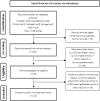Cholangiocarcinoma Attributed to Occupation: A Systematic Reviews
- PMID: 35763622
- PMCID: PMC9587819
- DOI: 10.31557/APJCP.2022.23.6.1837
Cholangiocarcinoma Attributed to Occupation: A Systematic Reviews
Abstract
Background: The occurrence of a cluster of occupational cholangiocarcinoma(CCA) cases among Japanese workers at a small offset printing plant led to the hypotheses that occupational exposure was the root cause of this cancer. Numerous workplace carcinogens can be found at various jobs sites and are integral to various industrial processes. Therefore, a systematic evaluation of potential occupationally-related CCA and likely exposure types is needed.
Objective: To conduct a systematic review on the cause of CCA in relation to occupation.
Methods: The systematic review included papers published between 1980 and 2020. Databases included PubMed, Science Direct, CINAHL, ProQuest Medical Library, Springer, Wiley online library, and the Cochrane library. The review focused on CCA, intrahepatic CCA(as distinct from other types of liver cancer), and extrahepatic CCA(not including the gallbladder). While some occupations involve an expected risk of exposure to carcinogens, this study sought both primary reports on specific carcinogens or surrogates by occupation or industry title. Of the 65 English version abstracts, 18 studies were selected for in-depth review according to the eligibility criteria. Two occupational physicians independently assessed the relevance to the study objectives, data extractability, and data quality as per the Newcastle-Ottawa Scale.
Results: The review revealed that ten observational studies met the eligibility criteria. There was heterogeneity of occupational exposure assessment and the reported results. The possible carcinogens statistical significantly related to the incidence or mortality of CCA risk included 1,2-dichloropropane (the highest RR = 32.40, 95%CI=6.40-163.90), asbestos (the highest OR=4.81, 95 % CI =1.73-13.33), endocrine-disrupting compounds (the highest OR =2.00, 95% CI=1.10-3.70), and rotating shift work (the highest HR =1.97, 95%CI=1.02-3.79). These carcinogens are classified as IARC class 1 and 2A.
Conclusions: Despite the limited number of studies reviewed, the hypothesis of occupational risk for CCA was supported. Occupational health and safety measures may decrease exposure to these carcinogens, and surveillance in high-risk occupations or industries is urgently needed to prevent and control CCA.
Keywords: OCCUPATIONAL EXPOSURE; bile duct neoplasms; cholangiocarcinoma; occupational disease.
Conflict of interest statement
The authors have no conflicts of interest associated with the material presented in this paper.
Figures
References
-
- Ahrens W, Mambetova C, Bourdon-Raverdy N, et al. Occupational exposure to endocrine-disrupting compounds and biliary tract cancer among men. Scand J Work Environ Health. 2007;33:387–96. - PubMed
-
- Banales JM, Cardinale V, Carpino G, et al. Expert consensus document: Cholangiocarcinoma: current knowledge and future perspectives consensus statement from the European Network for the Study of cholangiocarcinoma (ENS-CCA) Nat Rev Gastroenterol Hepatol. 2016;13:261–80. - PubMed
-
- Bergquist A, von Seth E. Epidemiology of cholangiocarcinoma. Best Pract Res Clin Gastroenterol. 2015;29:221–32. - PubMed
Publication types
MeSH terms
Substances
LinkOut - more resources
Full Text Sources
Medical
Miscellaneous


